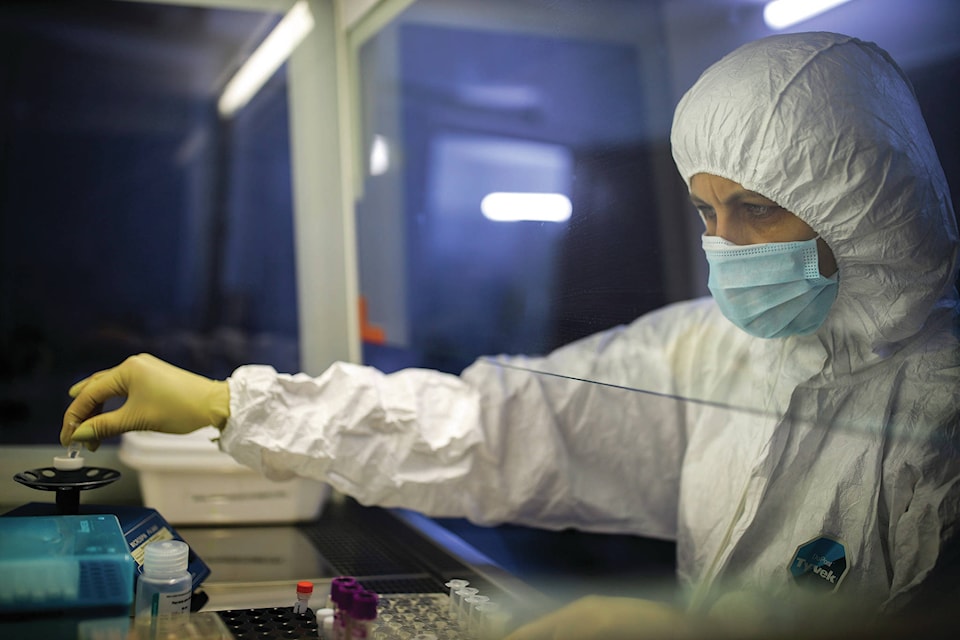The Philadelphia Inquirer
PHILADELPHIA —Faraz Zaidi and Daniel Park peered at a series of small, black blots that appeared on a clear sheet of plastic —confirming they had created a type of protein that, until January, was unknown to science.
It was a signal alerting them to the presence of the microscopic “spikes” on a coronavirus —the infectious microbe that, at last count, had killed more than 1,000 people in China.
Health officials worldwide have attempted to quell the outbreak by restricting travel, isolating infected people and quarantining others who were exposed to someone with the infection. But from the moment the Chinese government published the genetic code for the new virus in January, scientists such as Zaidi and Park have been racing to develop a more potent safeguard: a vaccine.
The pair work in the lab of David B. Weiner at Philadelphia’s Wistar Institute, which is collaborating with Plymouth Meeting-based Inovio Pharmaceuticals and other partners to deliver a vaccine within months.
That’s a fast timetable, made possible by a new approach Weiner helped pioneer when he worked at the University of Pennsylvania.
Unlike traditional vaccines, which contain killed or weakened forms of the virus in question, the Inovio product contains genetic instructions to make just a fragment of a virus: a single type of protein. The old method requires extensive testing to ensure the weakened viruses will not make anyone sick. The newer DNA vaccines can be proven safe much more quickly, said Weiner, who serves on Inovio’s board.
“If you wanted to do this the old-fashioned way, we’d be talking about a many-year project,” he said.
Whether the human immune system is being exposed to a weakened or killed virus, or just a fragment, the goal is the same: teaching the body to defend itself should it ever encounter a real infection.
Several other teams around the world are at work on vaccines against the new coronavirus, including a Johnson & Johnson lab in the Netherlands. Wistar, an independent research institution in West Philadelphia, has a long track record in the field, including development of vaccines against rubella, rabies and rotavirus, among others.
People who become infected with coronavirus tend to develop mild symptoms such as a cough, and recover on their own. But a minority of patients, even some who were young and had been in good health, have come down with severe, pneumonia-like symptoms. A vaccine is considered essential.
Inovio scientists “printed” their vaccine in a matter of hours with a DNA synthesizer: a computerized system that fuses together chemical base pairs in the correct order. Testing its safety and effectiveness in human subjects, however, will take months.
In the lab at Wistar, Zaidi and Park were testing one of several versions of the vaccine —verifying that the instructions, once delivered inside human cells, would cause the correct proteins to be made. Other tests were underway to ensure that the proteins were triggering an immune response, in the form of white blood cells called T-cells.
The proteins in question are the very ones that give the coronavirus family its name: the little spikes on the outer edge of each virus particle, giving the appearance of a corona, or crown, like the fringe surrounding a solar eclipse.
Other viruses for which vaccines have been made with this approach include Ebola, HIV and MERS, a different type of coronavirus.
These DNA vaccines are not administered in the usual way, because if you simply injected DNA into a person’s bloodstream, enzymes would degrade it before it had a chance to penetrate cells.
Instead, DNA vaccines are administered with a device that has several metal probes on the end. The probes are placed against the skin, delivering a small electric current that opens tiny pores in skin cells, Weiner said.
These cellular “micropores” remain open for just a split second, long enough to take in about 1,000 copies of the necessary DNA instructions in each cell. The vaccine remains confined to cells in that immediate patch of skin.
“It’s all just local,” Weiner said.
The cells then make the proteins, which teach the immune system how to mount a two-pronged response: learning to create both the infection-fighting T-cells and B-cells.
In the event of an actual infection, B-cells are the first line of defense —producing tailored antibodies that can kill a virus as it floats through the bloodstream, before it infects the patient’s lungs.
But once the virus infects cells, hijacking their machinery to make millions of copies of itself, it is too late for antibodies. The immune system then delivers T-cells to the site of infection, where they kill the infected cells outright.
Inovio and Wistar are partnering with a Chinese company, Beijing Advaccine Biotechnology Co. The project is supported by a $9 million grant from the Coalition for Epidemic Preparedness Innovations, a Norway-based coalition of public and private partners that funds vaccine development and distribution.
Should the vaccine prove effective, among the first to get it would be health care workers.
First comes testing in laboratory animals, which is expected to be finished by late spring, said J. Joseph Kim, the president and chief executive officer of Inovio. The goal is to start human tests in early summer, both here and in China, he said.
“The virus is spreading quite rapidly,” Kim said. “We believe the vaccine development has to match that speed.”
———
(c)2020 The Philadelphia Inquirer
Visit The Philadelphia Inquirer at www.inquirer.com
Distributed by Tribune Content Agency, LLC.
—————
PHOTO (for help with images, contact 312-222-4194): CORONAVIRUS-VACCINE-LAB
